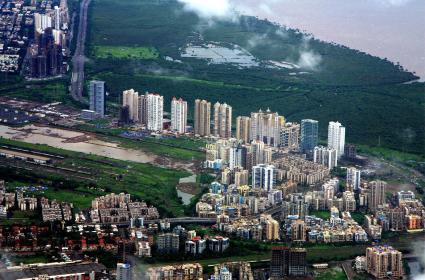Navi Mumbai: Best Planned But Worst Implemented

Mahesh Vijapurkar
Navi Mumbai is by far the largest planned new city which even four decades after it was embarked upon is even now a work in progress. It is larger by at least a third compared to Andhra Pradesh’s new capital city, Amaravati. Navi Mumbai’s conceiver, the late Charles Correa, architect and town planner, had long ago ruefully admitted that it was a failed attempt.
It hasn’t shaped the way it was to have, growing at a snail’s pace. The incremental development was funded by auction of land which the planning authority owned, and that pushed the real estate prices up. Soon after the idea of a new airport at Panvel emerged, even the farther corners of the Navi Mumbai project area saw real estate prices shoot up like the towers that came to be.
Now Navi Mumbai, which was to have been one city, a tad smaller than the area of entire Mumbai city which it was to have decongested, is going to be several. The first parcel of over 100 sq km was municipalised in 1992 even as the planning authority, CIDCO (state-owned City & Industrial Development Corp.) during the time that segment was being built, ignored the habitats which were earlier villages but attended only to the areas (in Telugu, seemamu) around them.
Now, another slice beyond the part comprising Digha, Belapur, and Vashi, has been incorporated as a separate municipal corporation, contiguous to Navi Mumbai Municipal Corporation (NMMC)’s jurisdiction. It is not as if one half was developed and after a critical mass had been achieved, a new one was being municipalised by adding them to NMMC.
It is to be called the Panvel Municipal Corporation. But even here, CIDCO chose to demand that a segment it calls NAINA be left out of Panvel civic body. NAINA is an acronym for New Airport Influence Notified Area within the sprawl meant for Navi Mumbai originally when initiated in early 1970s.
It may well end up as a distinct new city and have the same name, like Noida in National Capital Region is. Noida is the acronym for New Okhla Industrial Development Area, around a village then called Okhla. It will be about the size of NMMC. Not that these could not have been part of the old Navi Mumbai plan.
When Correa passed away, his friend, Anil Dharkar had written about the former had known about how “disappointing Navi Mumbai was (to Correa): He knew it had failed in its main objective, and admitted it ruefully; the failure was not of the planners but was a result of political will.” Correa himself had warned years earlier how “Market forces do not make a city, they destroy them. It is as true of Mumbai as it is for Navi Mumbai.”
The new urban space is being governed by market forces. The region across the Mumbai harbour was chosen and linked by a bridge which could deal with only road traffic when even scooters and motorbikes were not affordable to the class which was being pushed to occupy it.
Small plots were laid out – just plots, plots with two sides having walls – for the poor to come live and some tenements were built, typically in the government standards of quality. Even before the NMMC could see its area bloom, they had become dilapidated, and villages ignored turned slum-like. It helped politicians to refuse to shift the state government offices and the legislature from Mumbai to Navi Mumbai, and that slowed the pace of progress of the newly being created urban space.
That simultaneously saw reclamation of land from the sea in Mumbai, now Nariman Point, and that made some very rich, and retarded others. At one time CIDCO had sought a floor to space ratio (FSI) of 7 for Navi Mumbai to make it more compact and draw people to itself. It is wrong to see the towers that have come up and are coming up nodes in the entire project area, NMMC, Panvel Municipal Corporation, as the shining new urban dream.
They are expensive because builders bought the plots in auction, and the villages which are out of sight are also getting crowded and expensive. It should not be a surprise that a decade ago, there were more slum dwellers in Navi Mumbai than there were residents in the neglected villages.














